Assassin’s Creed theme by RsinArt
Download: Assassins_Creed.p3t

The #1 spot for Playstation themes!
Heroes theme by Xehos
Download: Heroes.p3t
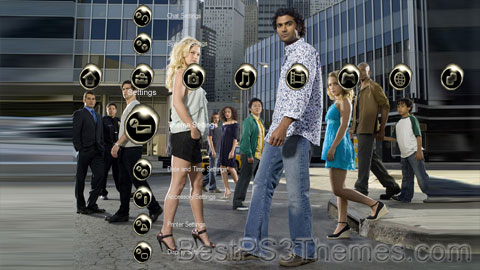
(3 backgrounds)
P3T Unpacker v0.12
Copyright (c) 2007. Anoop Menon
This program unpacks Playstation 3 Theme files (.p3t) so that you can touch-up an existing theme to your likings or use a certain wallpaper from it (as many themes have multiple). But remember, if you use content from another theme and release it, be sure to give credit!
Download for Windows: p3textractor.zip
Instructions:
Download p3textractor.zip from above. Extract the files to a folder with a program such as WinZip or WinRAR. Now there are multiple ways to extract the theme.
The first way is to simply open the p3t file with p3textractor.exe. If you don’t know how to do this, right click the p3t file and select Open With. Alternatively, open the p3t file and it will ask you to select a program to open with. Click Browse and find p3textractor.exe from where you previously extracted it to. It will open CMD and extract the theme to extracted.[filename]. After that, all you need to do for any future p3t files is open them and it will extract.
The second way is very simple. Just drag the p3t file to p3textractor.exe. It will open CMD and extract the theme to extracted.[filename].
For the third way, first put the p3t file you want to extract into the same folder as p3textractor.exe. Open CMD and browse to the folder with p3extractor.exe. Enter the following:
p3textractor filename.p3t [destination path]Replace filename with the name of the p3t file, and replace [destination path] with the name of the folder you want the files to be extracted to. A destination path is not required. By default it will extract to extracted.filename.
Playstation Beyond theme 1.50 by Otic
Download: playb3yond.p3t
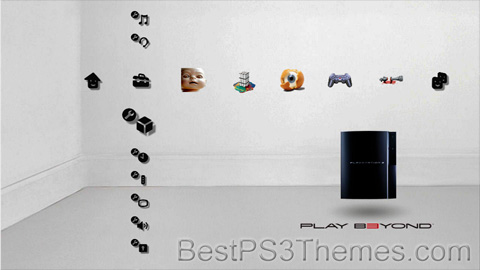
(1 background HD, 3 sample backgrounds SD)
P3T Unpacker v0.12
Copyright (c) 2007. Anoop Menon
This program unpacks Playstation 3 Theme files (.p3t) so that you can touch-up an existing theme to your likings or use a certain wallpaper from it (as many themes have multiple). But remember, if you use content from another theme and release it, be sure to give credit!
Download for Windows: p3textractor.zip
Instructions:
Download p3textractor.zip from above. Extract the files to a folder with a program such as WinZip or WinRAR. Now there are multiple ways to extract the theme.
The first way is to simply open the p3t file with p3textractor.exe. If you don’t know how to do this, right click the p3t file and select Open With. Alternatively, open the p3t file and it will ask you to select a program to open with. Click Browse and find p3textractor.exe from where you previously extracted it to. It will open CMD and extract the theme to extracted.[filename]. After that, all you need to do for any future p3t files is open them and it will extract.
The second way is very simple. Just drag the p3t file to p3textractor.exe. It will open CMD and extract the theme to extracted.[filename].
For the third way, first put the p3t file you want to extract into the same folder as p3textractor.exe. Open CMD and browse to the folder with p3extractor.exe. Enter the following:
p3textractor filename.p3t [destination path]Replace filename with the name of the p3t file, and replace [destination path] with the name of the folder you want the files to be extracted to. A destination path is not required. By default it will extract to extracted.filename.
Pink Floyd theme by wolfgang187
Download: PinkFloydHD.p3t
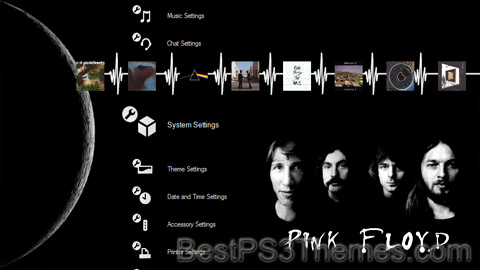
(1 background)
Pink Floyd | |
|---|---|
 Pink Floyd in January 1968. Clockwise from bottom: David Gilmour, Nick Mason, Syd Barrett, Roger Waters and Richard Wright. | |
| Background information | |
| Also known as |
|
| Origin | London, England |
| Genres | |
| Discography | Pink Floyd discography |
| Years active |
|
| Labels | |
| Spinoffs | Nick Mason's Saucerful of Secrets |
| Members | |
| Past members | |
| Website | pinkfloyd |
Pink Floyd are an English rock band formed in London in 1965. Gaining an early following as one of the first British psychedelic groups, they were distinguished by their extended compositions, sonic experiments, philosophical lyrics, and elaborate live shows. They became a leading band of the progressive rock genre, cited by some as the greatest progressive rock band of all time.
Pink Floyd were founded in 1965 by Syd Barrett (guitar, lead vocals), Nick Mason (drums), Roger Waters (bass guitar, vocals) and Richard Wright (keyboards, vocals). With Barrett as their main songwriter, they released two hit singles, "Arnold Layne" and "See Emily Play", and the successful debut album The Piper at the Gates of Dawn (all 1967). David Gilmour (guitar, vocals) joined in December 1967, while Barrett left in April 1968 due to deteriorating mental health. The four remaining members began contributing to the musical composition, with Waters becoming the primary lyricist and thematic leader, devising the concepts behind Pink Floyd's most successful albums, The Dark Side of the Moon (1973), Wish You Were Here (1975), Animals (1977) and The Wall (1979). The musical film based on The Wall, Pink Floyd – The Wall (1982), won two BAFTA Awards. Pink Floyd also composed several film scores.
Following personal tensions, Wright left Pink Floyd in 1981, followed by Waters in 1985. Gilmour and Mason continued as Pink Floyd, rejoined later by Wright. They produced the albums A Momentary Lapse of Reason (1987) and The Division Bell (1994), backed by major tours, before entering a long hiatus. In 2005, all but Barrett reunited for a performance at the global awareness event Live 8. Barrett died in 2006, and Wright in 2008. The last Pink Floyd studio album, The Endless River (2014), was based on unreleased material from the Division Bell recording sessions. In 2022, Gilmour and Mason reformed Pink Floyd to release the song "Hey, Hey, Rise Up!" in protest at the Russian invasion of Ukraine.
By 2013, Pink Floyd had sold more than 250 million records worldwide, making them one of the best-selling music artists of all time. The Dark Side of the Moon and The Wall were inducted into the Grammy Hall of Fame,[1] and these albums and Wish You Were Here are among the best-selling albums of all time. Four Pink Floyd albums topped the US Billboard 200, and five topped the UK Albums Chart. Pink Floyd's hit singles include "Arnold Layne" (1967), "See Emily Play" (1967), "Money" (1973), "Another Brick in the Wall, Part 2" (1979), "Not Now John" (1983), "On the Turning Away" (1987) and "High Hopes" (1994). They were inducted into the US Rock and Roll Hall of Fame in 1996 and the UK Music Hall of Fame in 2005. In 2008, Pink Floyd were awarded the Polar Music Prize in Sweden for their contribution to modern music.
The founding members of Pink Floyd were Roger Waters, Nick Mason, and Richard Wright, who enrolled at the London Polytechnic at Regent Street in Sept 1962 to study architecture,[2] and Syd Barrett, two years younger than the rest of the band, who had moved to London in 1964 to study at the Camberwell College of Arts.[3] Waters and Barrett were childhood friends; Waters had often visited Barrett and watched him play guitar at Barrett's mother's house.[4] Mason said about Barrett: "In a period when everyone was being cool in a very adolescent, self-conscious way, Syd was unfashionably outgoing; my enduring memory of our first encounter is the fact that he bothered to come up and introduce himself to me."[5]
Waters and Mason met while studying architecture at the London Polytechnic at Regent Street.[2] They first played music together in a group formed by fellow students Keith Noble and Clive Metcalfe,[6] with Noble's sister Sheilagh. Richard Wright, a fellow architecture student,[nb 1] joined later that year, and the group became a sextet, Sigma 6. Waters played lead guitar, Mason drums, and Wright rhythm guitar, later moving to keyboards.[8] The band performed at private functions and rehearsed in a tearoom in the basement of the Regent Street Polytechnic. They performed songs by the Searchers and material written by their manager and songwriter, fellow student Ken Chapman.[9]
In September 1963, Waters and Mason moved into a flat at 39 Stanhope Gardens, Highgate in London, owned by Mike Leonard,[10] a part-time tutor at the nearby Hornsey College of Art and the Regent Street Polytechnic.[11][nb 2] Mason moved out after the 1964 academic year, and guitarist Bob Klose moved in during September 1964, prompting Waters's switch to bass.[12][nb 3] Sigma 6 went through several names, including the Meggadeaths, the Abdabs and the Screaming Abdabs, Leonard's Lodgers, and the Spectrum Five, before settling on the Tea Set.[13][nb 4] In September 1963, as Metcalfe and Noble left to form their own band,[17] guitarist Syd Barrett joined Klose and Waters at Stanhope Gardens.[18] Klose introduced the band to singer Chris Dennis, a technician with the Royal Air Force (RAF).[19] In December 1964, they secured their first recording time, at a studio in West Hampstead, through one of Wright's friends, who let them use some down time free. Wright, who was taking a break from his studies, did not participate in the session.[20][nb 5] When the RAF assigned Dennis a post in Bahrain in early 1965, Barrett became the band's frontman.[21][nb 6] Later that year, they became the resident band at the Countdown Club near Kensington High Street in London, where from late night until early morning they played three sets of 90 minutes each. During this period, spurred by the group's need to extend their sets to minimise song repetition, the band realised that "songs could be extended with lengthy solos", wrote Mason.[22] After pressure from his parents and advice from his college tutors, Klose quit the band in mid-1965 and Barrett took over lead guitar.[23]
The group rebranded as the Pink Floyd Sound in late 1965. Barrett created the name on the spur of the moment when he discovered that another band, also called the Tea Set, were to perform at one of their gigs.[24] The name is derived from the given names of two blues musicians whose Piedmont blues records Barrett had in his collection, Pink Anderson and Floyd Council.[25] By 1966, the group's repertoire consisted mainly of rhythm and blues songs, and they had begun to receive paid bookings, including a performance at the Marquee Club in December 1966, where Peter Jenner, a lecturer at the London School of Economics, noticed them. Jenner was impressed by the sonic effects Barrett and Wright created and, with his business partner and friend Andrew King, became their manager.[26] The pair had little experience in the music industry and used King's inheritance to set up Blackhill Enterprises, purchasing about £1,000 (equivalent to £23,500 in 2023[27]) worth of new instruments and equipment for the band.[nb 7] Around this time, Jenner suggested the band drop the "Sound" from their name.[29]
Under Jenner and King's guidance, Pink Floyd became part of London's underground music scene, playing at venues including All Saints Hall and the Marquee.[30] While performing at the Countdown Club, the band had experimented with long instrumental excursions, and they began to expand them with rudimentary but effective light shows, projected by coloured slides and domestic lights.[31] Jenner and King's social connections helped gain the band prominent coverage in the Financial Times and an article in the Sunday Times which stated: "At the launching of the new magazine IT the other night a pop group called the Pink Floyd played throbbing music while a series of bizarre coloured shapes flashed on a huge screen behind them ... apparently very psychedelic."[32]
In 1966, the band strengthened their business relationship with Blackhill Enterprises, becoming equal partners with Jenner and King and the band members each holding a one-sixth share.[29] By late 1966, their set included fewer R&B standards and more Barrett originals, many of which would be included on their first album.[33] While they had significantly increased the frequency of their performances, the band were still not widely accepted. Following a performance at a Catholic youth club, the owner refused to pay them, claiming that their performance was not music.[34] When their management filed suit in a small claims court against the owner of the youth organisation, a local magistrate upheld the owner's decision. The band was much better received at the UFO Club in London, where they began to build a fan base.[35] Barrett's performances were enthusiastic, "leaping around ... madness ... improvisation ... [inspired] to get past his limitations and into areas that were ... very interesting. Which none of the others could do", wrote biographer Nicholas Schaffner.[36]
In 1967, Pink Floyd began to attract the attention of the music industry.[37][nb 8] While in negotiations with record companies, IT co-founder and UFO club manager Joe Boyd and Pink Floyd's booking agent, Bryan Morrison, arranged and funded a recording session at Sound Techniques in Kensington.[39] On 15 February 1967, Pink Floyd signed with EMI, receiving a £5,000 advance (equivalent to £114,600 in 2023[27]). EMI released the band's first single, "Arnold Layne", with the B-side "Candy and a Currant Bun", on 10 March 1967 on its Columbia label.[40][nb 9] Both tracks were recorded on 29 January 1967.[41][nb 10] "Arnold Layne"'s references to cross-dressing led to a ban by several radio stations; however, creative manipulation by the retailers who supplied sales figures to the music business meant that the single reached number 20 in the UK.[43]
EMI-Columbia released Pink Floyd's second single, "See Emily Play", on 16 June 1967. It fared slightly better than "Arnold Layne", peaking at number 6 in the UK.[44] The band performed on the BBC's Look of the Week, where Waters and Barrett, erudite and engaging, faced tough questioning from Hans Keller.[45] They appeared on the BBC's Top of the Pops, a popular programme that controversially required artists to mime their singing and playing.[46] Though Pink Floyd returned for two more performances, by the third, Barrett had begun to unravel, and around this time the band first noticed significant changes in his behaviour.[47] By early 1967, he was regularly using LSD, and Mason described him as "completely distanced from everything going on".[48]
Morrison and EMI producer Norman Smith negotiated Pink Floyd's first recording contract. As part of the deal, the band agreed to record their first album at EMI Studios in London.[49][nb 11] Mason recalled that the sessions were trouble-free. Smith disagreed, stating that Barrett was unresponsive to his suggestions and constructive criticism.[51] EMI-Columbia released The Piper at the Gates of Dawn in August 1967. The album reached number six, spending 14 weeks on the UK charts.[52] One month later, it was released under the Tower Records label.[53] Pink Floyd continued to draw large crowds at the UFO Club; however, Barrett's mental breakdown was by then causing serious concern. The group initially hoped that his erratic behaviour would be a passing phase, but some were less optimistic, including Jenner and his assistant, June Child, who commented: "I found [Barrett] in the dressing room and he was so ... gone. Roger Waters and I got him on his feet, [and] we got him out to the stage ... The band started to play and Syd just stood there. He had his guitar around his neck and his arms just hanging down".[54]
Forced to cancel Pink Floyd's appearance at the prestigious National Jazz and Blues Festival, as well as several other shows, King informed the music press that Barrett was suffering from nervous exhaustion.[55] Waters arranged a meeting with psychiatrist R. D. Laing, and though Waters personally drove Barrett to the appointment, Barrett refused to come out of the car.[56] A stay in Formentera with Sam Hutt, a doctor well established in the underground music scene, led to no visible improvement. The band followed a few concert dates in Europe during September with their first tour of the US in October.[57][nb 12] As the US tour went on, Barrett's condition grew steadily worse.[59] During appearances on the Dick Clark and Pat Boone shows in November, Barrett confounded his hosts by giving terse answers to questions (or not responding at all) and staring into space. He refused to move his lips when it came time to mime "See Emily Play" on Boone's show. After these embarrassing episodes, King ended their US visit and immediately sent them home to London.[60][nb 13] Soon after their return, they supported Jimi Hendrix during a tour of England; however, Barrett's depression worsened as the tour continued.[62][nb 14]
In December 1967, reaching a crisis point with Barrett, Pink Floyd added guitarist David Gilmour as the fifth member.[65][66][nb 15] Gilmour already knew Barrett, having studied with him at Cambridge Tech in the early 1960s.[4] The two had performed at lunchtimes together with guitars and harmonicas, and later hitch-hiked and busked their way around the south of France.[68] In 1965, while a member of Joker's Wild, Gilmour had watched the Tea Set.[69]
Morrison's assistant, Steve O'Rourke, set Gilmour up in a room at O'Rourke's house with a salary of £30 per week (equivalent to £700 in 2023[27]). In January 1968, Blackhill Enterprises announced Gilmour as the band's newest member, intending to continue with Barrett as a nonperforming songwriter.[70] According to Jenner, the group planned that Gilmour would "cover for [Barrett's] eccentricities". When this proved unworkable, it was decided that Barrett would just write material.[71][nb 16] In an expression of his frustration, Barrett, who was expected to write additional hit singles to follow up "Arnold Layne" and "See Emily Play", instead introduced "Have You Got It Yet?" to the band, intentionally changing the structure on each performance so as to make the song impossible to follow and learn.[65] In a January 1968 photoshoot of Pink Floyd, the photographs show Barrett looking detached from the others, staring into the distance.[73]
Working with Barrett eventually proved too difficult, and matters came to a conclusion in January while en route to a performance in Southampton when a band member asked if they should collect Barrett. According to Gilmour, the answer was "Nah, let's not bother", signalling the end of Barrett's tenure with Pink Floyd.[74][nb 17] Waters later said, "He was our friend, but most of the time we now wanted to strangle him."[76] In early March 1968, Pink Floyd met with business partners Jenner and King to discuss the band's future; Barrett agreed to leave.[77]
Jenner and King believed Barrett was the creative genius of the band, and decided to represent him and end their relationship with Pink Floyd.[78] Morrison sold his business to NEMS Enterprises, and O'Rourke became the band's personal manager.[79] Blackhill announced Barrett's departure on 6 April 1968.[80][nb 18] After Barrett's departure, the burden of lyrical composition and creative direction fell mostly on Waters.[82] Initially, Gilmour mimed to Barrett's voice on the group's European TV appearances; however, while playing on the university circuit, they avoided Barrett songs in favour of Waters and Wright material such as "It Would Be So Nice" and "Careful with That Axe, Eugene".[83] Mason said later that Gilmour added greater structure to Pink Floyd's music and that "we became far less difficult to enjoy, I think".[84]

In 1968, Pink Floyd returned to Abbey Road Studios to complete their second album, A Saucerful of Secrets, which they had begun in 1967 under Barrett's leadership. The album included Barrett's final contribution to their discography, "Jugband Blues". Waters developed his own songwriting, contributing "Set the Controls for the Heart of the Sun", "Let There Be More Light", and "Corporal Clegg". Wright composed "See-Saw" and "Remember a Day". Norman Smith encouraged them to self-produce their music, and they recorded demos of new material at their houses. With Smith's instruction at Abbey Road, they learned how to use the recording studio to realise their artistic vision. However, Smith remained unconvinced by their music, and when Mason struggled to perform his drum part on "Remember a Day", Smith stepped in as his replacement.[85] Wright recalled Smith's attitude about the sessions, "Norman gave up on the second album ... he was forever saying things like, 'You can't do twenty minutes of this ridiculous noise'".[86] As neither Waters nor Mason could read music, to illustrate the structure of "A Saucerful of Secrets", they invented their own system of notation. Gilmour later described their method as looking "like an architectural diagram".[87]
Released in June 1968, A Saucerful of Secrets featured a psychedelic cover designed by Storm Thorgerson and Aubrey Powell of Hipgnosis. The first of several Pink Floyd album covers designed by Hipgnosis, it was the second time that EMI permitted one of their groups to contract designers for an album jacket.[88] The release reached number nine, spending 11 weeks on the UK chart.[52] Record Mirror gave the album an overall favourable review, but urged listeners to "forget it as background music to a party".[87] John Peel described a live performance of the title track as "like a religious experience", while NME described the song as "long and boring ... [with] little to warrant its monotonous direction".[86][nb 19] On the day after the album's UK release, Pink Floyd performed at the first ever free concert in Hyde Park.[90] In July 1968, they made a second visit to the US. Accompanied by the Soft Machine and the Who, it marked Pink Floyd's first major tour.[91] That December, they released "Point Me at the Sky"; no more successful than the two singles they had released since "See Emily Play", it was their last single until "Money" in 1973.[92]
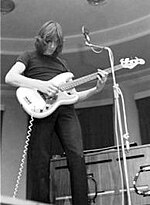
Ummagumma represented a departure from Pink Floyd's previous work. Released as a double LP on EMI's Harvest label, the first two sides contained live performances recorded at Manchester College of Commerce and Mothers, a club in Birmingham. The second LP contained a single experimental contribution from each band member.[93] Ummagumma was released in November 1969 and received positive reviews.[94] It reached number five, spending 21 weeks on the UK chart.[52] In October 1970, Pink Floyd released Atom Heart Mother.[95][nb 20] An early version premièred in England in mid January, but disagreements over the mix prompted the hiring of Ron Geesin to work out the sound problems. Geesin worked to improve the score, but with little creative input from the band, production was troublesome. Geesin eventually completed the project with the aid of John Alldis, who was the director of the choir hired to perform on the record. Smith earned an executive producer credit, and the album marked his final official contribution to the band's discography. Gilmour said it was "A neat way of saying that he didn't ... do anything".[97] Waters was critical of Atom Heart Mother, claiming that he would prefer if it were "thrown into the dustbin and never listened to by anyone ever again".[98] Gilmour once described it as "a load of rubbish", stating: "I think we were scraping the barrel a
Orange Skin theme by GeneralOfDeath
Download: OrangeSkin.p3t
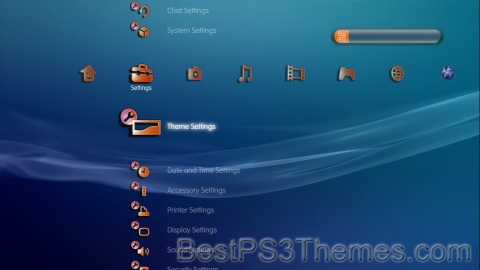
(no backgrounds)
P3T Unpacker v0.12
Copyright (c) 2007. Anoop Menon
This program unpacks Playstation 3 Theme files (.p3t) so that you can touch-up an existing theme to your likings or use a certain wallpaper from it (as many themes have multiple). But remember, if you use content from another theme and release it, be sure to give credit!
Download for Windows: p3textractor.zip
Instructions:
Download p3textractor.zip from above. Extract the files to a folder with a program such as WinZip or WinRAR. Now there are multiple ways to extract the theme.
The first way is to simply open the p3t file with p3textractor.exe. If you don’t know how to do this, right click the p3t file and select Open With. Alternatively, open the p3t file and it will ask you to select a program to open with. Click Browse and find p3textractor.exe from where you previously extracted it to. It will open CMD and extract the theme to extracted.[filename]. After that, all you need to do for any future p3t files is open them and it will extract.
The second way is very simple. Just drag the p3t file to p3textractor.exe. It will open CMD and extract the theme to extracted.[filename].
For the third way, first put the p3t file you want to extract into the same folder as p3textractor.exe. Open CMD and browse to the folder with p3extractor.exe. Enter the following:
p3textractor filename.p3t [destination path]Replace filename with the name of the p3t file, and replace [destination path] with the name of the folder you want the files to be extracted to. A destination path is not required. By default it will extract to extracted.filename.
God of War theme by Droops
Download: GodOfWarThemeByDroops.p3t
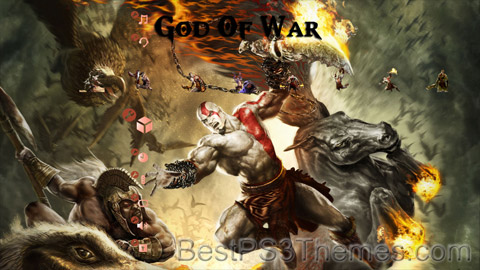
(2 backgrounds, 1 HD, 1 SD)
A god of war is a deity associated with war.
God of War or Gods of War may also refer to:
Glossy Blue theme by chasgta
Download: GlossyBlue.p3t
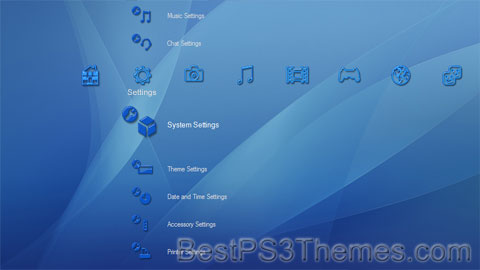
(1 background)
P3T Unpacker v0.12
Copyright (c) 2007. Anoop Menon
This program unpacks Playstation 3 Theme files (.p3t) so that you can touch-up an existing theme to your likings or use a certain wallpaper from it (as many themes have multiple). But remember, if you use content from another theme and release it, be sure to give credit!
Download for Windows: p3textractor.zip
Instructions:
Download p3textractor.zip from above. Extract the files to a folder with a program such as WinZip or WinRAR. Now there are multiple ways to extract the theme.
The first way is to simply open the p3t file with p3textractor.exe. If you don’t know how to do this, right click the p3t file and select Open With. Alternatively, open the p3t file and it will ask you to select a program to open with. Click Browse and find p3textractor.exe from where you previously extracted it to. It will open CMD and extract the theme to extracted.[filename]. After that, all you need to do for any future p3t files is open them and it will extract.
The second way is very simple. Just drag the p3t file to p3textractor.exe. It will open CMD and extract the theme to extracted.[filename].
For the third way, first put the p3t file you want to extract into the same folder as p3textractor.exe. Open CMD and browse to the folder with p3extractor.exe. Enter the following:
p3textractor filename.p3t [destination path]Replace filename with the name of the p3t file, and replace [destination path] with the name of the folder you want the files to be extracted to. A destination path is not required. By default it will extract to extracted.filename.
Star Wars theme by PenguinRage
Download: StarWars_by_PenguinRage.p3t
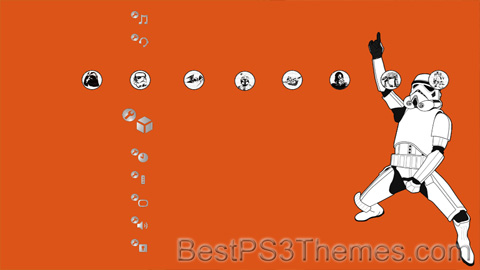
(3 backgrounds)
| Star Wars | |
|---|---|
 | |
| Created by | George Lucas |
| Original work | Star Wars (1977)[a] |
| Owner | Lucasfilm |
| Years | 1977–present |
| Print publications | |
| Book(s) | List of reference books |
| Novel(s) | List of novels |
| Short stories | See list of novels |
| Comics | List of comics |
| Comic strip(s) | See list of comics |
| Magazine(s) | Star Wars Insider (1987–present) |
| Films and television | |
| Film(s) | List of films |
| Television series | List of television series |
| Television special(s) | See list of television series |
| Television film(s) | See list of films |
| Games | |
| Role-playing | List of RPGs |
| Video game(s) | List of video games |
| Audio | |
| Radio program(s) | List of radio dramas |
| Original music | Music |
| Miscellaneous | |
| Toy(s) | Merchandise |
| Theme park attraction(s) | List of attractions |
Star Wars is an American epic space opera media franchise created by George Lucas, which began with the eponymous 1977 film[a] and quickly became a worldwide pop culture phenomenon. The franchise has been expanded into various films and other media, including television series, video games, novels, comic books, theme park attractions, and themed areas, comprising an all-encompassing fictional universe.[b] Star Wars is one of the highest-grossing media franchises of all time.
The original 1977 film, retroactively subtitled Episode IV: A New Hope, was followed by the sequels Episode V: The Empire Strikes Back (1980) and Episode VI: Return of the Jedi (1983), forming the original Star Wars trilogy. Lucas later returned to the series to write and direct a prequel trilogy, consisting of Episode I: The Phantom Menace (1999), Episode II: Attack of the Clones (2002), and Episode III: Revenge of the Sith (2005). In 2012, Lucas sold his production company to Disney, relinquishing his ownership of the franchise. This led to a sequel trilogy, consisting of Episode VII: The Force Awakens (2015), Episode VIII: The Last Jedi (2017), and Episode IX: The Rise of Skywalker (2019).
All nine films, collectively referred to as the "Skywalker Saga", were nominated for Academy Awards, with wins going to the first two releases. Together with the theatrical live action "anthology" films Rogue One (2016) and Solo (2018), the combined box office revenue of the films equated to over US$10 billion, making Star Wars the third-highest-grossing film franchise of all time.
The Star Wars franchise depicts the adventures of characters "A long time ago in a galaxy far, far away"[2] across multiple fictional eras, in which humans and many species of aliens (often humanoid) co-exist with robots (typically referred to in the films as 'droids'), which may be programmed for personal assistance or battle.[3] Space travel between planets is common due to lightspeed hyperspace technology.[4][5][6] The planets range from wealthy, planet-wide cities to deserts scarcely populated by primitive tribes. Virtually any Earth biome, along with many fictional ones, has its counterpart as a Star Wars planet which, in most cases, teem with sentient and non-sentient alien life.[7] The franchise also makes use of other astronomical objects such as asteroid fields and nebulae.[8][9] Spacecraft range from small starfighters to large capital ships, such as the Star Destroyers, as well as space stations such as the moon-sized Death Stars.[10][11][12] Telecommunication includes two-way audio and audiovisual screens, holographic projections and hyperspace transmission.[13]
The universe of Star Wars is generally similar to the real universe but its laws of physics are less strict allowing for more imaginative stories.[14] One result of that is a mystical power known as the Force which is described in the original film as "an energy field created by all living things ... [that] binds the galaxy together".[15] The field is depicted as a kind of pantheistic god.[16] Through training and meditation, those whom "the Force is strong with" exhibit various superpowers (such as telekinesis, precognition, telepathy, and manipulation of physical energy).[17] It is believed nothing is impossible for the Force.[18] The mentioned powers are wielded by two major knightly orders at conflict with each other: the Jedi, peacekeepers of the Galactic Republic who act on the light side of the Force through non-attachment and arbitration, and the Sith, who use the dark side by manipulating fear and aggression.[19][20] While Jedi Knights can be numerous, the Dark Lords of the Sith (or 'Darths') are intended to be limited to two: a master and their apprentice.[21]
The franchise is set against a backdrop of galactic conflict involving republics and empires, such as the evil Galactic Empire.[22] The Jedi and Sith prefer the use of a weapon called the lightsaber, a blade of plasma that can cut through virtually any surface and deflect energy bolts.[23] The rest of the population, as well as renegades and soldiers, use plasma-powered blaster firearms.[24] In the outer reaches of the galaxy, crime syndicates such as the Hutt cartel are dominant.[25] Bounty hunters are often employed by both gangsters and governments, while illicit activities include smuggling and slavery.[25]
The combination of science fiction and fantasy elements makes Star Wars a very universal franchise, capable of telling stories of various genres.[26]
| Film | U.S. release date | Directed by | Screenplay by | Story by | Produced by | Refs. | |
|---|---|---|---|---|---|---|---|
| Original trilogy: Episodes IV–VI | |||||||
| Star Wars | May 25, 1977 | George Lucas | Gary Kurtz | [27][28] | |||
| The Empire Strikes Back | May 21, 1980 | Irvin Kershner | Leigh Brackett and Lawrence Kasdan | George Lucas | [29][30] | ||
| Return of the Jedi | May 25, 1983 | Richard Marquand | Lawrence Kasdan and George Lucas | Howard Kazanjian | [31][32] | ||
| Prequel trilogy: Episodes I–III | |||||||
| The Phantom Menace | May 19, 1999 | George Lucas | George Lucas | George Lucas | Rick McCallum | [33] | |
| Attack of the Clones | May 16, 2002 | George Lucas and Jonathan Hales | [34][35] | ||||
| Revenge of the Sith | May 19, 2005 | George Lucas | [36][37] | ||||
| Sequel trilogy: Episodes VII–IX | |||||||
| The Force Awakens | December 18, 2015 | J. J. Abrams | Lawrence Kasdan, J. J. Abrams and Michael Arndt | Kathleen Kennedy, J.J. Abrams and Bryan Burk | [31][38] | ||
| The Last Jedi | December 15, 2017 | Rian Johnson | Kathleen Kennedy and Ram Bergman | [39][40] | |||
| The Rise of Skywalker | December 20, 2019 | J. J. Abrams | Chris Terrio and J. J. Abrams | Derek Connolly, Colin Trevorrow, J.J. Abrams, and Chris Terrio | Kathleen Kennedy, J. J. Abrams and Michelle Rejwan | [41][42] | |

The Star Wars film series centers around three sets of trilogies, the nine films of which are collectively referred to as the "Skywalker Saga".[43] The saga was produced non-chronologically, beginning in media res with the release of the original trilogy between 1977 and 1983. This was followed by the prequel trilogy, released between 1999 and 2005, and the sequel trilogy, released between 2015 and 2019.[44]
Each trilogy focuses on a generation of the Force-sensitive Skywalker family and their struggle against the evil Sith lord Palpatine (Darth Sidious).[45] The original trilogy depicts the heroic development of Luke Skywalker as a Jedi and his fight against Palpatine's Galactic Empire alongside his sister, Leia.[46] The prequels tell the tragic backstory of their father, Anakin, who is corrupted by Palpatine and becomes Darth Vader.[47] The sequels follow the conflict between Leia's son, Ben Solo, and Luke and Leia's protegé, Rey, and their eventual alliance against Palpatine after the fall of the Empire.[48]
In 1971, George Lucas wanted to film an adaptation of the Flash Gordon serial, but could not obtain the rights, so he began developing his own space opera.[49][c] After directing American Graffiti (1973), he wrote a two-page synopsis, which 20th Century Fox decided to invest in.[50][51] By 1974, he had expanded the story into the first draft of a screenplay.[52] Fox expected the film would be of limited financial success, and so it was given a relatively low budget, with production being moved to Elstree Studios in England to help save on cost.[53]
Star Wars was released on May 25, 1977, and first subtitled Episode IV: A New Hope in the 1979 book The Art of Star Wars.[54] The film's success led Lucas to make it the basis of an elaborate film serial.[55] With the backstory he created for the sequel, Lucas decided that the series would be a trilogy of trilogies.[56] Episode V: The Empire Strikes Back was released on May 21, 1980, also achieving wide financial and critical success. The final film in the trilogy, Episode VI: Return of the Jedi, was released on May 25, 1983.
According to producer Gary Kurtz, loose plans for a prequel trilogy were developed during the outlining of the original two films.[57] In 1980, Lucas confirmed that he had the nine-film series plotted,[58] but due to the stress of producing the original trilogy, he had decided to cancel further sequels by 1981.[59] In 1983, Lucas explained that "There was never a script completed that had the entire story as it exists now ... As the stories unfolded, I would take certain ideas and save them ... I kept taking out all the good parts, and I just kept telling myself I would make other movies someday."[60]
Technical advances in the late 1980s and early 1990s, including the ability to create computer-generated imagery (CGI), inspired Lucas to consider that it might be possible to revisit his saga. In 1989, Lucas stated that the prequels would be "unbelievably expensive".[61] In 1992, he acknowledged that he had plans to create the prequel trilogy.[62] A theatrical rerelease of the original trilogy in 1997 "updated" the 20-year-old films with the style of CGI envisioned for the new trilogy.[63]
Episode I: The Phantom Menace was released on May 19, 1999, Episode II: Attack of the Clones on May 16, 2002, and Episode III: Revenge of the Sith on May 19, 2005.[64] The first two films were met with mixed reviews, with the third being received somewhat more positively. Together with the original trilogy, Lucas has referred to the first six episodic films of the franchise as "the tragedy of Darth Vader".[65]
Prior to releasing the original 1977 film, and made possible by its success, Lucas planned "three trilogies of nine films".[56][66] However, he announced to Time in 1978 that he planned "10 sequels".[67] He confirmed that he had outlined the prequels and sequels in 1981.[68] At various stages of development, the sequel trilogy was to focus on the rebuilding of the Republic,[69] the return of Luke as a Jedi Master (a role similar to that of Obi-Wan Kenobi in the original trilogy),[66] Luke's sister (not yet determined to be Leia),[57] Han, Leia,[70] R2-D2 and C-3PO.[56][71] However, after beginning work on the prequel trilogy, Lucas insisted that Star Wars was meant to be a six-part series and that there would be no sequel trilogy.[72][73]
Lucas decided to leave the franchise in the hands of other filmmakers, announcing in January 2012 that he would make no more Star Wars films.[74] That October, the Walt Disney Company agreed to buy Lucasfilm and announced that Episode VII would be released in 2015.[75] The co-chairman of Lucasfilm, Kathleen Kennedy, became president and served as executive producer of new Star Wars feature films.[76] Lucas provided Kennedy his story treatments for the sequels during the 2012 sale,[77] but in 2015 it was revealed Lucas's sequel outline had been discarded.[78][79] The sequel trilogy also meant the end of the Star Wars Expanded Universe stories, which were discarded from canon to give "maximum creative freedom to the filmmakers and also preserve an element of surprise and discovery for the audience."[1]
Episode VII: The Force Awakens was released on December 16, 2015, Episode VIII: The Last Jedi on December 13, 2017, and Episode IX: The Rise of Skywalker on December 18, 2019, in many countries.[e] The Force Awakens and T
Okami theme by m0dus
Download: okami_m0dus.p3t
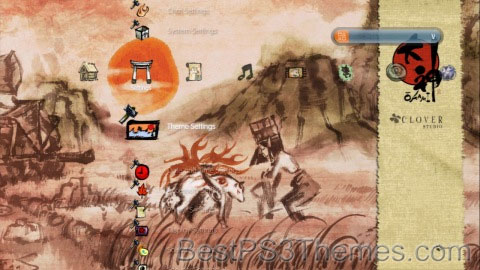
(1 background)
P3T Unpacker v0.12
Copyright (c) 2007. Anoop Menon
This program unpacks Playstation 3 Theme files (.p3t) so that you can touch-up an existing theme to your likings or use a certain wallpaper from it (as many themes have multiple). But remember, if you use content from another theme and release it, be sure to give credit!
Download for Windows: p3textractor.zip
Instructions:
Download p3textractor.zip from above. Extract the files to a folder with a program such as WinZip or WinRAR. Now there are multiple ways to extract the theme.
The first way is to simply open the p3t file with p3textractor.exe. If you don’t know how to do this, right click the p3t file and select Open With. Alternatively, open the p3t file and it will ask you to select a program to open with. Click Browse and find p3textractor.exe from where you previously extracted it to. It will open CMD and extract the theme to extracted.[filename]. After that, all you need to do for any future p3t files is open them and it will extract.
The second way is very simple. Just drag the p3t file to p3textractor.exe. It will open CMD and extract the theme to extracted.[filename].
For the third way, first put the p3t file you want to extract into the same folder as p3textractor.exe. Open CMD and browse to the folder with p3extractor.exe. Enter the following:
p3textractor filename.p3t [destination path]Replace filename with the name of the p3t file, and replace [destination path] with the name of the folder you want the files to be extracted to. A destination path is not required. By default it will extract to extracted.filename.
LittleBigPlanet theme by PenguinRage
Download: LittleBigPlanet.p3t
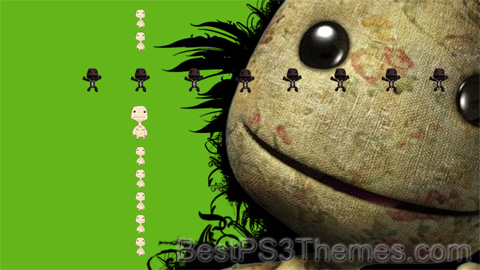
(3 backgrounds)
| LittleBigPlanet | |
|---|---|
 | |
| Genre(s) | Platform, endless running |
| Developer(s) | Media Molecule (2008-2014) SCE Studio Cambridge (2009) Supermassive Games (2010) XDev (2010-2012) Double Eleven (2012) Tarsier Studios (2012) United Front Games (2012) San Diego Studio (2012) Firesprite (2014) Sumo Digital (2014-2020) Exient Entertainment (2023) |
| Publisher(s) | Sony Interactive Entertainment PlayStation Mobile (2014) |
| Platform(s) | PlayStation 3 PlayStation Portable PlayStation Vita PlayStation 4 PlayStation 5 Windows |
| First release | LittleBigPlanet 27 October 2008 |
| Latest release | Ultimate Sackboy March 3, 2023 |
LittleBigPlanet (LBP - stylised as LittleBIGPlanet) is a puzzle platform video game series created and produced by British developer Media Molecule and published by Sony Interactive Entertainment. Most games in the series put a strong emphasis on user-generated content and are based on the series' tagline "Play, Create, Share". The tagline represents the three core elements of the series: playing alone or with others locally (on the same console) or online, creating new content using the in-game creation tools, and sharing creations and discoveries online with other players.
Tarsier Studios, Fireproof Games and Supermassive Games also contribute to the development of the PlayStation 3 games, creating in-game assets (downloadable content) including costumes, backgrounds, objects, and stickers. Some of these assets will also provide the player more tools and gadgets to use in the level editor.[1]
The series comprises six games across five gaming platforms. The series was launched in 2008 with the PlayStation 3 game LittleBigPlanet, which was followed in 2009 by a PlayStation Portable version of the same name, initially developed by Studio Liverpool[2] and later handed to SCE Studio Cambridge. The sequel to the PlayStation 3 version, LittleBigPlanet 2, was released in January 2011 alongside a smaller spin-off title called Sackboy's Prehistoric Moves. LittleBigPlanet PS Vita was developed by Tarsier Studios and Double Eleven, released in September 2012 for the PlayStation Vita. At E3 2014, Sony announced LittleBigPlanet 3, a PlayStation 4 instalment that was developed by Sumo Digital and released in November 2014.[3] The games are all published by Sony Computer Entertainment. The latest instalment for the LittleBigPlanet franchise titled Sackboy: A Big Adventure was revealed during the PS5 live event and released on the PlayStation 4 and PlayStation 5 in November 2020. A Windows version was released on 27 October 2022.[4]
On 17 January 2015, it was announced that all LittleBigPlanet servers in Japan would shut down on 31 July, along with the PlayStation Portable version and LittleBigPlanet Karting in late August in all regions. Due to attacks on the online servers, all LittleBigPlanet servers were taken down in May 2021 (the Vita version had remained closed since March).[5] The servers for the PS4 version of LittleBigPlanet 3 were brought back up on 13 September 2021, however, in the same announcement, it mentioned that the servers for LittleBigPlanet, LittleBigPlanet 2, LittleBigPlanet PS Vita and the PS3 version of LittleBigPlanet 3 will remain closed permanently.[6] On 8 January, 2024, it was announced that, presumably due to more attacks on the online servers, the servers for the PS4 version of LittleBigPlanet 3 were being temporarily closed while they investigate them.[7][8][9]
On 19 April 2024, the servers for the PlayStation 4 version of LittleBigPlanet 3 were permanently shut down due to ongoing technical issues.[10]
The core mechanics of the series revolve around its tagline, "Play, Create, Share".[11]
In the first two instalments of the series, gameplay consist primarily of traditional two-dimensional look in a three-dimensional style platforming like jumping and avoiding obstacles to successfully navigate to the end of a level to win.[12] Since LittleBigPlanet 2, the series has included mini-games, including ones that do not follow the platformer genre. Most LittleBigPlanet games involve a player playing solo or co-operatively with friends to navigate through a level whilst collecting various "bubbles" along the way, which can take the form of either points or collectibles. In-game collectibles can be used in level creation or to customize Sackboy, the player character. There are also numerous co-operative parts of levels whereby certain prize bubbles can be earned. In LittleBigPlanet 3 and Sackboy: A Big Adventure, Collectables are also present, being used in various shops to purchase more costumes.
The Create component primarily refers to level creation in the game, along with other features like character customisation. Players can create their own levels with the built-in level creator. Many items that are collected while playing through the story mode and from LittleBigPlanet's community can be used to help with level creation.[13] These levels can remain as the original LittleBigPlanet platforming gameplay, or they can include other game types, such as racing, fighting, shooting and sports.[12] The player can also make non-gaming creations such as music and films (commonly known in-game as cut-scenes).[14] In LittleBigPlanet 2, Sackbots were introduced to give players more control over non-player characters in their levels as well as make the levels in their entirety more intelligent. The creation technique introduced on the game gave the possibility for logic, and it gave the ability to build sets of machines and complex contraptions.[14]
Lastly, the Share component relates to sharing creations with the game's community by uploading levels to the PlayStation Network. To-date there were an excess of ten million user-created levels available to play on the LittleBigPlanet server in the PlayStation 3 games.[15] After the release of LittleBigPlanet 2 and the LBP.me community website, the Share component also had a strong emphasis sharing discoveries. Players were encouraged to share levels they found with other players by writing reviews and comments in-game and by sharing links to creations' LBP.me pages via social networks.
The series takes place in a world known as LittleBigPlanet. Each curator is in charge of a part of LittleBigPlanet and they govern them independently. LittleBigPlanet has geography inspired by the real-life Earth. All games in the series follow the main protagonist Sackboy, a small anthropomorphic creature made of brown fabric with a zip fastener and button eyes. He can be customized to the player's liking using costumes that are either unlocked in the game or bought as downloadable content from the PlayStation Store. The player can control Sackboy's four emotions; happiness, sadness, worry and anger, each of which has three levels of intensity. The English language version of each game is narrated by Stephen Fry and in all formats Fry's scripts are written by Dean Wilkinson.
| 2008 | LittleBigPlanet |
|---|---|
| 2009 | LittleBigPlanet (PSP) |
| 2010 | Sackboy's Prehistoric Moves |
| 2011 | LittleBigPlanet 2 |
| 2012 | LittleBigPlanet PS Vita |
| LittleBigPlanet Karting | |
| 2013 | |
| 2014 | Run Sackboy! Run! |
| LittleBigPlanet 3 | |
| 2015 | |
| 2016 | |
| 2017 | |
| 2018 | |
| 2019 | |
| 2020 | Sackboy: A Big Adventure |
| 2021 | |
| 2022 | |
| 2023 | Ultimate Sackboy |
The first game in the series was released on the PlayStation 3 platform in 2008 and was the first title developed by Media Molecule, under the name The Next Big Thing. The player controls Sackboy as he travels around the titular LittleBigPlanet, helping the eight creator curators of LittleBigPlanet with their problems in their own respective realms. Throughout the story, Sackboy tries to stop The Collector, one of the eight creator curators who has gone rogue, kidnapping the creations of LittleBigPlanet.[16] The game received widespread acclaim for its design, gameplay, and customization afforded to the player, particularly the built-in level editor. After its release, it received numerous industry awards.[17]
The second game in the series is a direct sequel to the first LittleBigPlanet and was developed by Media Molecule for the PlayStation 3 for a release in 2011. The sequel saw a major shift in the direction of the series, going from a primarily traditional platform game in the first two entries to a more varied style of gameplay called a "platform for games". The second game gave players a wider variety of options when it came to level design, which saw the creation of levels other than platforming such as racing, puzzles, and fighting games.[18] Following the events of the first two entries in the series, the game takes place when an antagonist known as the Negativitron invades LittleBigPlanet and begins to suck up all its inhabitants. Sackboy must team up with a secret organization known as "The Alliance", led by Larry Da Vinci, to save LittleBigPlanet from the Negativitron.[19] The game also supported the PlayStation Move, with an update post-launch.
LittleBigPlanet 3 is a game for the PlayStation 3[20][21][22] and PlayStation 4. Announced at E3 2014, it was developed by Sumo Digital and was released in November 2014. In the game, Sackboy is transported to another world, Bunkum, where he has to awaken its three missing heroes, OddSock, Toggle and Swoop, who are new playable characters. Sackboy travels through different worlds in order to free the 3 new characters and stop Newton.[23]
A portable entry of the series was developed primarily by SCE Studio Cambridge in association with Media Molecule for the PlayStation Portable. The game, released in 2009, shared the same name as the original game; however, it was not a port of the PlayStation 3 game, but rather a new entry in the series. It has a story-mode with levels and features many of the same mechanics of its PlayStation 3 counterpart, such as customizations, albeit without the multiplayer component of the game. The game takes place after the events of the PlayStation 3 version of LittleBigPlanet, in which The Collector has been defeated. A carnival is being held and Sackboy decides to go around the world to invite the eight curators of LittleBigPlanet to the carnival whilst finding materials for his own carnival float.[24]
The fourth game in the series was developed by Tarsier Studios, Double Eleven, and XDev for the PlayStation Vita handheld and had a 2012 release.[25] The game features the same core mechanics from LittleBigPlanet 2, with the focus being on a "platform for games" rather than a platformer like previous entries in the series before LittleBigPlanet 2. The game utilizes the unique controls of the PlayStation Vita by using its multi-touch touchscreen and its rear touchpad to navigate through various obstacles in stages as well as for level creation by users.[26] The game supports cross-buy of DLC costume packs between LittleBigPlanet 2, as well as LittleBigPlanet Karting.
LittleBigPlanet Karting is a kart racing game developed by United Front and San Diego Studio in conjunction with series creator Media Molecule for the PlayStation 3.[27] In its story mode, the player ventures through worlds including: LittleBigPlanet, Monster Islands, Victoria's Laboratory, The Progress Emporium, Eve's Asylum, The Space Bass, and Hoard, Sweet Hoard, to put an end to the Hoard racers, who snatch many pieces of the different planets to stash them in the Garage at the End of the Universe. Sony Entertainment America shut down the North American LittleBigPlanet Karting online servers on 31 August 2016.[28]
The game was developed by XDev as a spin-off from the LittleBigPlanet series utilizing the PlayStation Move on the PlayStation 3. It was released in December 2010, as a downloadable title from the PlayStation Store and was later bundled with LittleBigPlanet 2. The game was described as a "demo" and featured 10 prehistoric inspired story levels. In the game, Sackboy must save Little Big Planet from the T-Rex. Unlike the main games, which can be played as a single-player experience, the game required a minimum of two players to work.[29] This was due to the main mechanics of the spin-off whereby one player would control Sackboy traditionally using the gamepad for platforming while a second player had to use a PlayStation Move similar to a pointer to move obstacles and objects out of the way in order to successfully navigate a level.[30]
Run Sackboy! Run! is a free-to-play endless running game developed by Firesprite and published by PlayStation Mobile that was released on iOS on 30 October 2014,[31] Android on 17 December 2014[32] and PlayStation Vita on 31 March 2015.[33] The game has no real plot, except for Sackboy running through Craftworld from the Negativitron. The game awarded players with exclusive costumes for LittleBigPlanet 3 (which was released at a similar time) by reaching point goals and collecting stickers.[34]
LittleBigPlanet Hub is an unreleased free-to-play game for the PlayStation 3.[35] It was planned to be a downloadable title from the PlayStation Store which would have allowed players to create levels and play a curated selection of community levels from LittleBigPlanet and LittleBigPlanet 2 as well as 16 levels from the games' story modes. LittleBigPlanet Hub would also have contained weekly challenges, not found in other LittleBigPlanet games. Downloadable content purchased in other games were to be compatible with LittleBigPlanet Hub, and users were rumoured to be also able to access additional content from the PlayStation Store.[citation needed]
Since its announcement in August 2013, no further details about LittleBigPlanet Hub were revealed.[36] In February 2024, a beta tester posted a video showing gameplay from a beta build onto YouTube, and shortly afterwards, with assistance, dumped it online for download. This makes the build playable through unofficial means, such as emulations like RPCS3 or PlayStation 3 homebrew.[37]
Sackboy: A Big Adventure is a 2020 platform game developed by Sumo Digital and published by Sony Interactive Entertainment for the PlayStation 5 and the PlayStation 4. It was announced at the PlayStation 5 reveal event on June 11, 2020, and was released on November 12, 2020; a version for Windows was released on October 27, 2022, marking the series's first release on PCs. Unlike previous LittleBigPlanet entries with 2.5D platforming, A Big Adventure features a range of perspectives and 3D movement.
Ultimate Sackboy is a free-to-play endless running game developed by Exient Entertainment and released on mobile on 21 February 2023. It is the first LittleBigPlanet game to feature limited-time paid subscriptions known as "Marathons." In contrast to Run Sackboy! Run!, it adopts the style from Sackboy: A Big Adventure and is played in 3D.
| Game | Metacritic |
|---|---|
| LittleBigPlanet (PlayStation 3) | 95/100[38] |
| LittleBigPlanet (PlayStation Portable) | 87/100[39] |
| Sackboy's Prehistoric Moves | 66/100[40] |
| LittleBigPlanet 2 | 91/100[41] |
| LittleBigPlanet PS Vita | 88/100[42] |
| LittleBigPlanet Karting | 74/100[43] |
| LittleBigPlanet 3 | 79/100[44] |
| Run Sackboy! Run! | 65/100[45] |
| Sackboy: A Big Adventure | 80/100[46] |
| Ultimate Sackboy | 57/100[47] |
Most of the games in the series have been well received by critics with the LittleBigPlanet on PlayStation 3 and PlayStation Portable gaining Metacritic scores of 95/100[38] and 87/100[39] respectively. LittleBigPlanet 2 garnered nearly as much acclaim as the first game, with an average score of 91/100.[48] LittleBigPlanet PS Vita also received very positive reviews and was the highest-ranked PS Vita game at the time of its release with an average score of 88/100.[49] However, the release of LittleBigPlanet 3 did not receive critical acclaim, garnering a mostly positive average of 79/100.[50] Critically, LittleBigPlanet Karting is the worst-performing major game in the series so far but still gained a "mixed or average" Metacritic score of 74/100.[51] However, the mobile game Run Sackboy! Run! performed worse, with a Metacritic score of 65/100.[52] Additionally, the character of Sackboy is often seen as a PlayStation mascot.[53] In 2011, readers of Guinness World Records Gamer's Edition voted Sackboy as the 50th-top video game character of all time.[54]